High-Efficiency Broadband Polarization-Independent Reflective Grating with Double-Layer Dielectric Rectangle Groove in Littrow Mounting
Abstract
:1. Introduction
2. Design
3. Results and Discussion
4. Conclusions
Author Contributions
Funding
Institutional Review Board Statement
Informed Consent Statement
Data Availability Statement
Conflicts of Interest
References
- Qi, J.; Wang, Z.; Huang, J.; Wang, Q.; Gao, J. Heterodyne interferometer with two parallel-polarized input beams for high-resolution roll angle measurement. Opt. Express 2019, 27, 13820–13830. [Google Scholar] [CrossRef]
- Wang, B.; Wang, X.; Li, Z.; Sasaki, O. Sinusoidal phase-modulating laser diode interferometer insensitive to intensity modulation for real-time displacement measurement with feedback control system. Opt. Commun. 2012, 285, 3827–3831. [Google Scholar] [CrossRef]
- Brand, M.; Zhang, B.; Onural, D.; Al Qubaisi, K.; Popović, M.; Dostart, N.; Wagner, K. High-resolution and compact serpentine integrated grating spectrometer. JOSA B 2021, 38, A75–A85. [Google Scholar] [CrossRef]
- Wirth, C.; Schmidt, O.; Tsybin, I.; Schreiber, T.; Eberhardt, R.; Limpert, J.; Andreas, T.; Klaus, L.; Michael, G.; Eric ten, H.; et al. High average power spectral beam combining of four fiber amplifiers to 8.2 kW. Opt. Lett. 2011, 36, 3118–3120. [Google Scholar] [CrossRef] [PubMed]
- Zheng, Y.; Yang, Y.; Wang, J.; Hu, M.; Liu, G.; Zhao, X.; Chen, X.; Liu, K.; Zhao, C.; He, B.; et al. 10.8 kW spectral beam combination of eight all-fiber superfluorescent sources and their dispersion compensation. Opt. Express 2016, 24, 12063–12071. [Google Scholar] [CrossRef] [PubMed]
- Yu, C.X.; Augst, S.J.; Redmond, S.M.; Goldizen, K.C.; Murphy, D.V.; Sanchez, A.; Fan, T.Y. Coherent combining of a 4 kW, eight-element fiber amplifier array. Opt. Lett. 2011, 36, 2686–2688. [Google Scholar] [CrossRef]
- Strickland, D.; Mourou, G. Compression of amplified chirped optical pulses. Opt. Commun. 1985, 55, 447–449. [Google Scholar] [CrossRef]
- Blanchot, N.; Bar, E.; Behar, G.; Bellet, C.; Bigourd, D.; Boubault, F.; Boubault, C.; Chappuis, H.; Coïc, C.; Damiens-Dupont, O.; et al. Rouyer Experimental demonstration of a synthetic aperture compression scheme for multi-Petawatt high-energy lasers. Opt. Express 2010, 18, 10088–10097. [Google Scholar] [CrossRef]
- Habara, H.; Xu, G.; Jitsuno, T.; Kodama, R.; Suzuki, K.; Sawai, K.; Kondo, K.; Miyanaga, N.; Tanaka, K.A.; Mima, K.; et al. Pulse compression and beam focusing with segmented diffraction gratings in a high-power chirped-pulse amplification glass laser system. Opt. Lett. 2010, 35, 1783–1785. [Google Scholar] [CrossRef]
- Martz, D.H.; Nguyen, H.T.; Patel, D.; Britten, J.A.; Alessi, D.; Krous, E.; Wang, Y.; Larotonda, M.A.; George, J.; Knollenberg, B.; et al. Large area high efficiency broad bandwidth 800 nm dielectric gratings for high energy laser pulse compression. Opt. Express 2009, 17, 23809–23816. [Google Scholar] [CrossRef]
- Mao, X.; Li, C.; Qiu, K.; Zeng, L.; Li, L.; Chen, X.; Wu, J.; Liu, Z.; Fu, S.; Hong, Y. Design and fabrication of 1300-line/mm polarization-independent reflection gratings for spectral beam combining. Opt. Commun. 2020, 458, 124883. [Google Scholar] [CrossRef]
- Chen, J.; Zhang, Y.; Wang, Y.; Kong, F.; Huang, H.; Wang, Y.; Jin, Y.; Chen, P.; Xu, J.; Shao, J. Polarization-independent broadband beam combining grating with over 98% measured diffraction efficiency from 1023 to 1080 nm. Opt. Lett. 2017, 42, 4016–4019. [Google Scholar] [CrossRef] [PubMed]
- Svakhin, A.S.; Sychugov, V.A.; Tikhomirov, A.E.; Mason, A. Efficient diffraction elements for TE-polarized waves. Soviet Phys. Tech. Phys. 1991, 36, 1038–1040. [Google Scholar]
- Svakhin, A.S.; Sychugov, V.A.; Tikhomirov, A.E. Diffraction gratings with high optical strength for laser resonators. Quantum Electron. 1994, 24, 233. [Google Scholar] [CrossRef]
- Yin, Z.; Yu, J.; Lu, Y.; Zhou, C. Broadband high-efficiency gratings operating at the 2nd order designed by simplified modal method. IEEE Photon. Technol. Lett. 2020, 32, 309–312. [Google Scholar] [CrossRef]
- Bonod, N.; Neauport, J. Diffraction gratings: From principles to applications in high-intensity lasers. Adv. Opt. Photon. 2016, 8, 156–199. [Google Scholar] [CrossRef]
- Palmier, S.; Neauport, J.; Baclet, N.; Lavastre, E.; Dupuy, G. High reflection mirrors for pulse compression gratings. Opt. Express 2009, 17, 20430–20439. [Google Scholar] [CrossRef]
- Bonod, N.; Neauport, J. Optical performance and laser induced damage threshold improvement of diffraction gratings used as compressors in ultra-high intensity lasers. Opt. Commun. 2006, 260, 649–655. [Google Scholar] [CrossRef]
- Canova, F.; Uteza, O.; Chambaret, J.P.; Flury, M.; Tonchev, S.; Fechner, R.; Parriaux, O. High-efficiency, broad band, high-damage threshold high-index gratings for femtosecond pulse compression. Opt. Express 2007, 15, 15324–15334. [Google Scholar] [CrossRef]
- Hu, A.; Zhou, C.; Cao, H.; Wu, J.; Yu, J.; Jia, W. Polarization-independent wideband mixed metal dielectric reflective gratings. Appl. Opt. 2012, 51, 4902–4906. [Google Scholar] [CrossRef]
- Moharam, M.G.; Gaylord, T.K. Rigorous coupled-wave analysis of planar-grating diffraction. J. Opt. Soc. Am. 1981, 71, 811–818. [Google Scholar] [CrossRef]
- Kirkpatrick, S.; Gelatt, C.D.; Vecchi, M.P. Optimization by simulated annealing. Science 1983, 220, 671–680. [Google Scholar] [CrossRef] [PubMed]
- Frei, B.; Balmer, J.E. 1053-nm-wavelength selection in a diode-laser-pumped Nd: YLF laser. Appl. Opt. 1994, 33, 6942–6946. [Google Scholar] [CrossRef] [PubMed]
- Al-Kuhaili, M.F. Optical properties of hafnium oxide thin films and their application in energy-efficient windows. Opt. Mater. 2004, 27, 383–387. [Google Scholar] [CrossRef]
- Green, M.A. Self-consistent optical parameters of intrinsic silicon at 300 K including temperature coefficients. Sol. Energ. Mat. Sol. Cells 2008, 92, 1305–1310. [Google Scholar] [CrossRef]
- Malitson, I.H. Interspecimen comparison of the refractive index of fused silica. J. Opt. Soc. Am. 1965, 55, 1205–1209. [Google Scholar] [CrossRef]
- Yang, H.U.; D’Archangel, J.; Sundheimer, M.L.; Tucker, E.; Boreman, G.D.; Raschke, M.B. Optical dielectric function of silver. Phys. Rev. B 2015, 91, 235137. [Google Scholar] [CrossRef]
- Xie, Y.; Jia, W.; Sun, P.; Xiang, C.; Jin, G.; Liu, W.; Zhou, B.; Zhou, C. Ultra-broadband polarization-independent high-efficiency transmission grating based on three-layer dielectric rectangle groove. J. Opt. 2021, 23, 075606. [Google Scholar] [CrossRef]
- Hu, A.; Zhou, C.; Cao, H.; Wu, J.; Yu, J.; Jia, W. Modal analysis of high-efficiency wideband reflective gratings. J. Opt. 2012, 14, 055705. [Google Scholar] [CrossRef]
- Botten, I.C.; Craig, M.S.; McPhedran, R.C.; Adams, J.L.; Andrewartha, J. The dielectric lamellar diffraction grating. Opt. Acta. 1981, 28, 413–428. [Google Scholar] [CrossRef]
- Lichtman, E. Limitations imposed by polarization-dependent gain and loss on all-optical ultralong communication systems. J. Lightwave Technol. 1995, 13, 906–913. [Google Scholar] [CrossRef]
- Delort, T.; Maystre, D. Finite-element method for gratings. J. Opt. Soc. Am. A 1993, 10, 2592–2601. [Google Scholar] [CrossRef]
- Hocquet, S.; Neauport, J.; Bonod, N. The role of electric field polarization of the incident laser beam in the short pulse damage mechanism of pulse compression gratings. Appl. Phys. Lett. 2011, 99, 061101. [Google Scholar] [CrossRef]
- Stuart, B.C.; Feit, M.D.; Herman, S.; Rubenchik, A.M.; Shore, B.W.; Perry, M.D. Optical ablation by high-power short-pulse lasers. J. Opt. Soc. Am. B 1996, 13, 459–468. [Google Scholar] [CrossRef]
- Zheng, J.; Zhou, C.; Feng, J.; Cao, H.; Lu, P. A metal-mirror-based reflecting polarizing beam splitter. J. Opt. A-Pure Appl. Opt. 2008, 11, 015710. [Google Scholar] [CrossRef]
- Shiozaki, M.; Shigehara, M. Novel design of polarization independent multi-layer diffraction grating with high angular dispersion. SEI Technol. Rev. 2005, 59, 27–31. [Google Scholar]
- Neauport, J.; Bonod, N.; Hocquet, S.; Palmier, S.; Dupuy, G. Mixed metal dielectric gratings for pulse compression. Opt. Express 2010, 18, 23776–23783. [Google Scholar] [CrossRef] [Green Version]

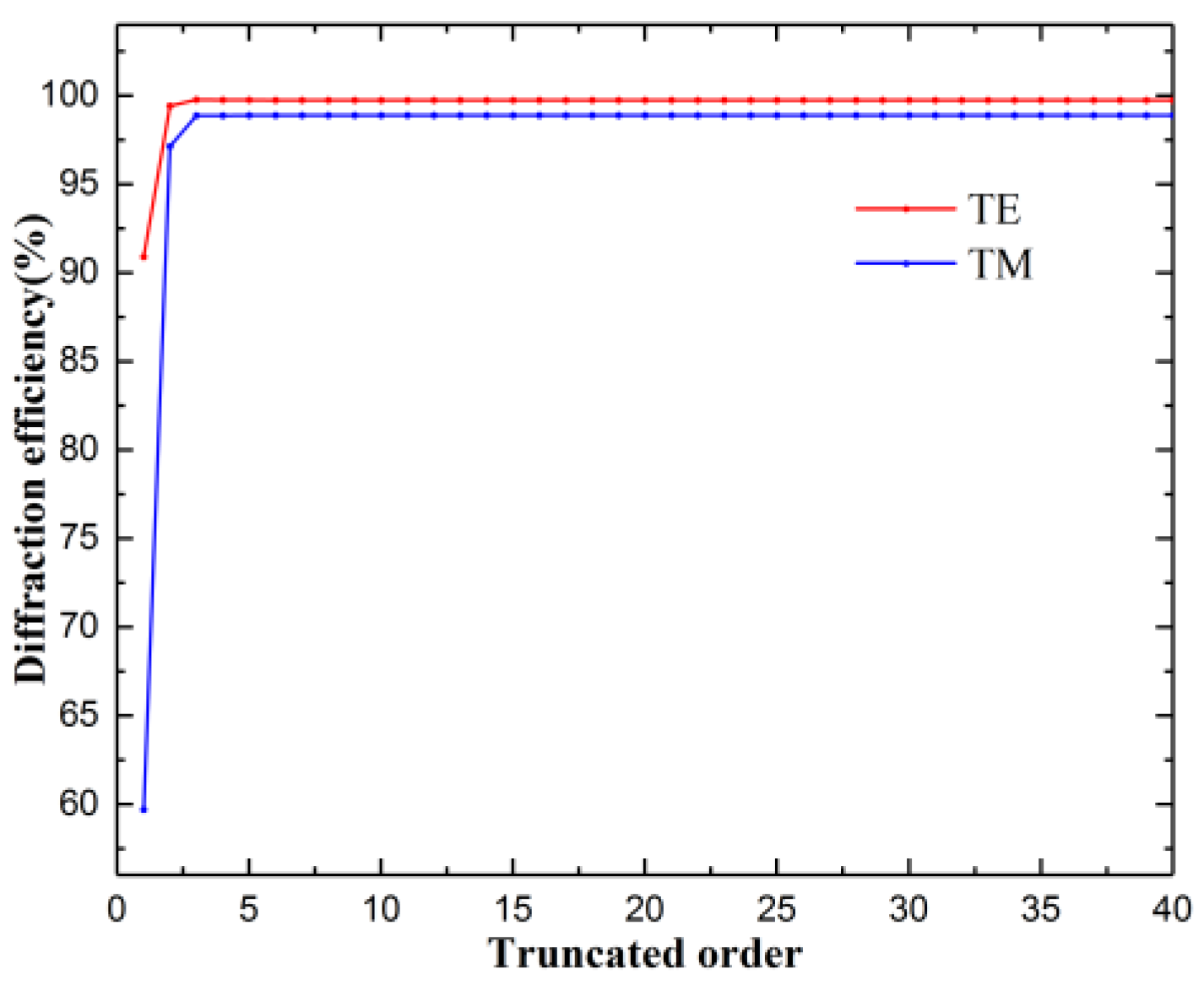
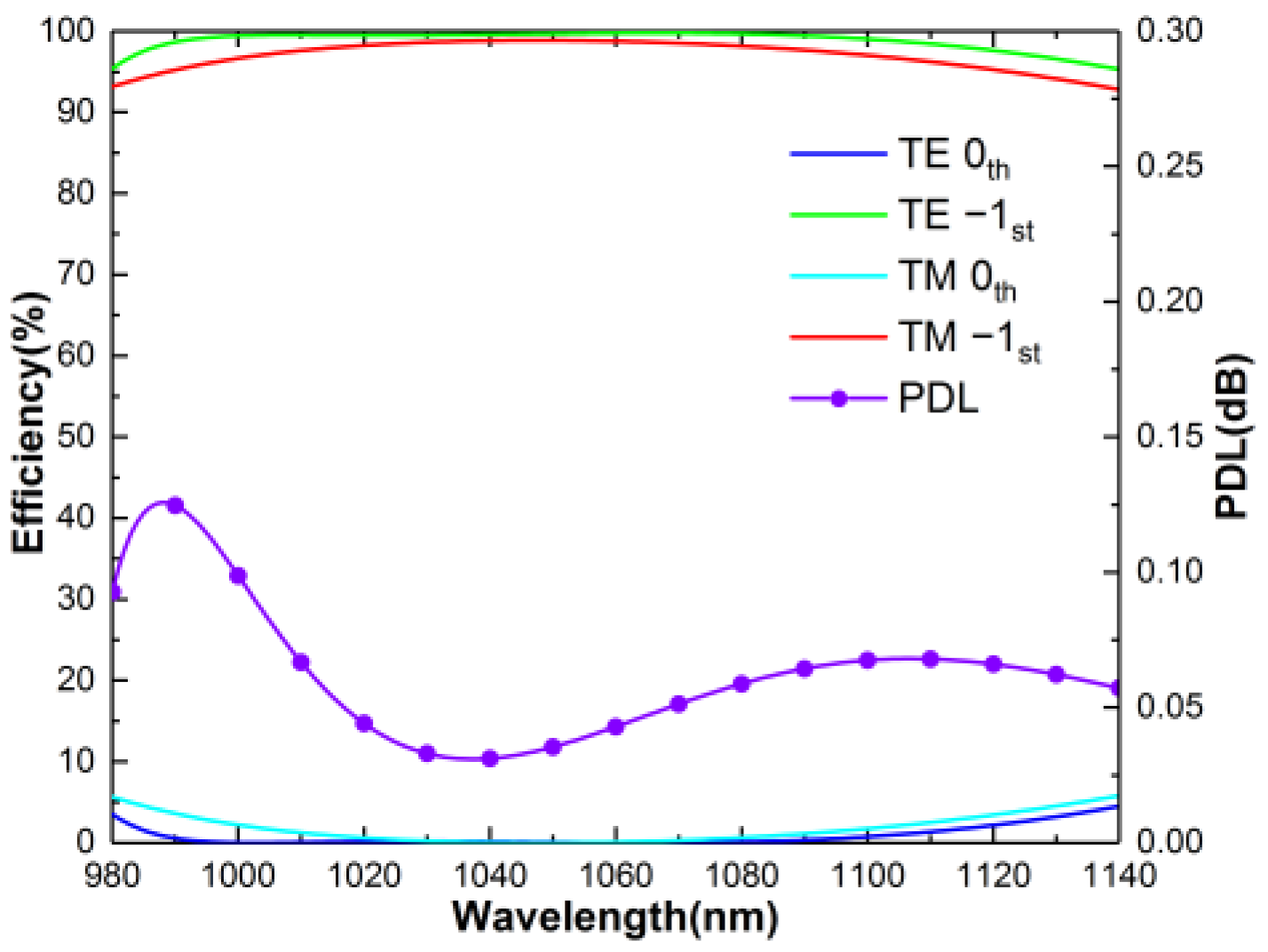
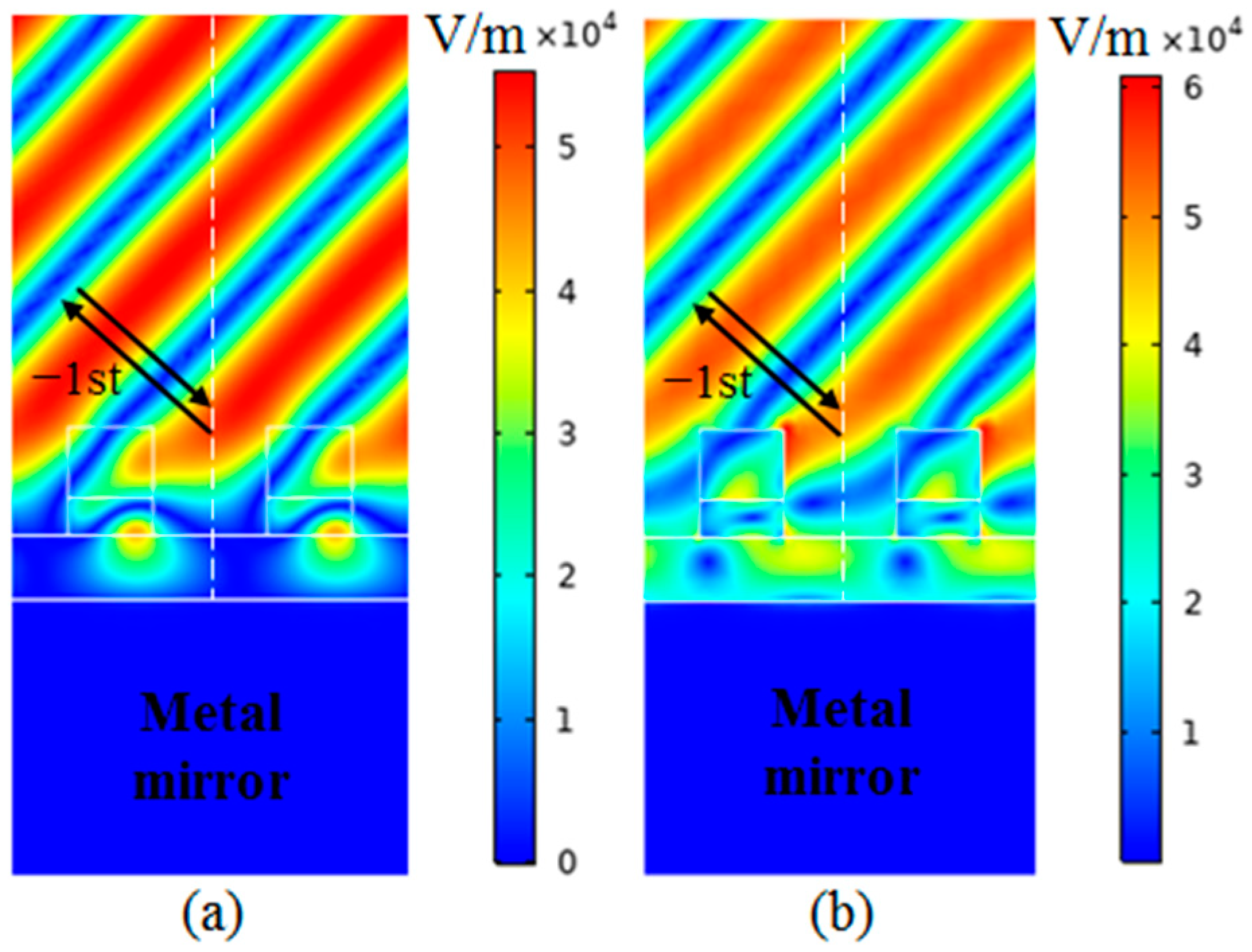
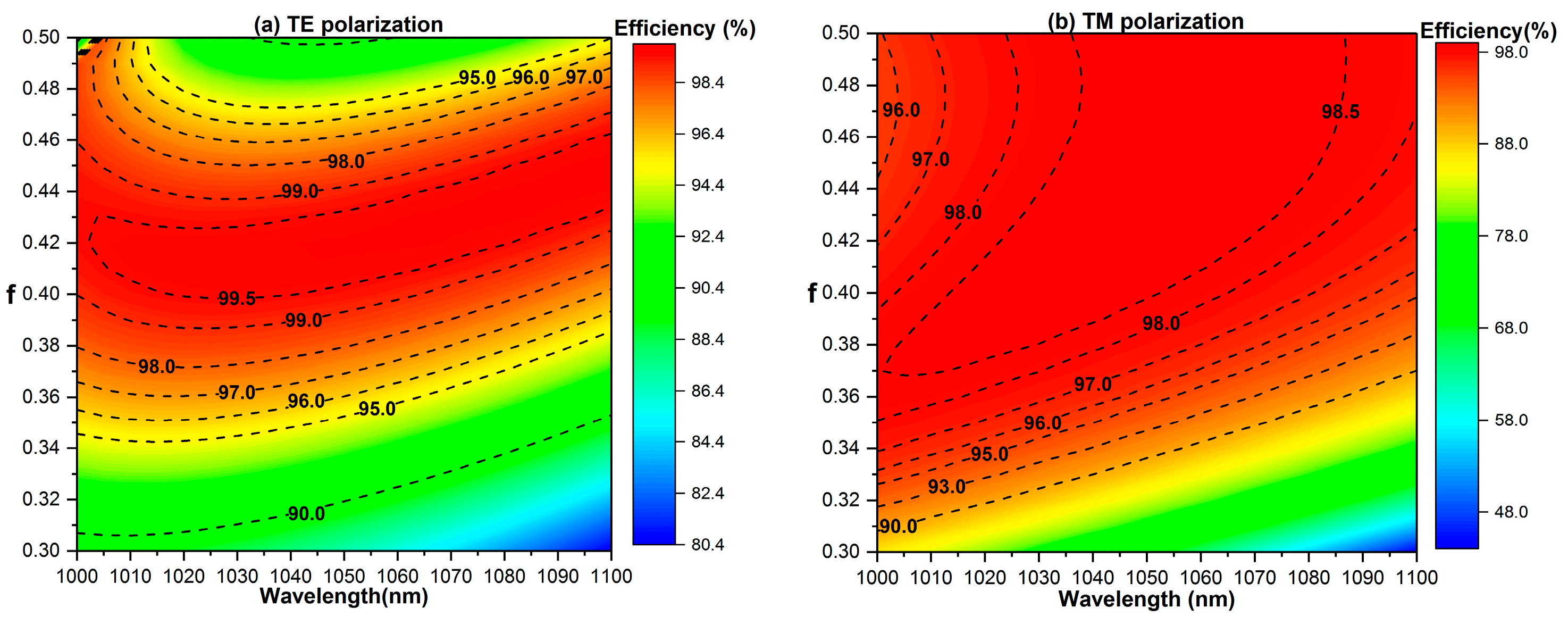
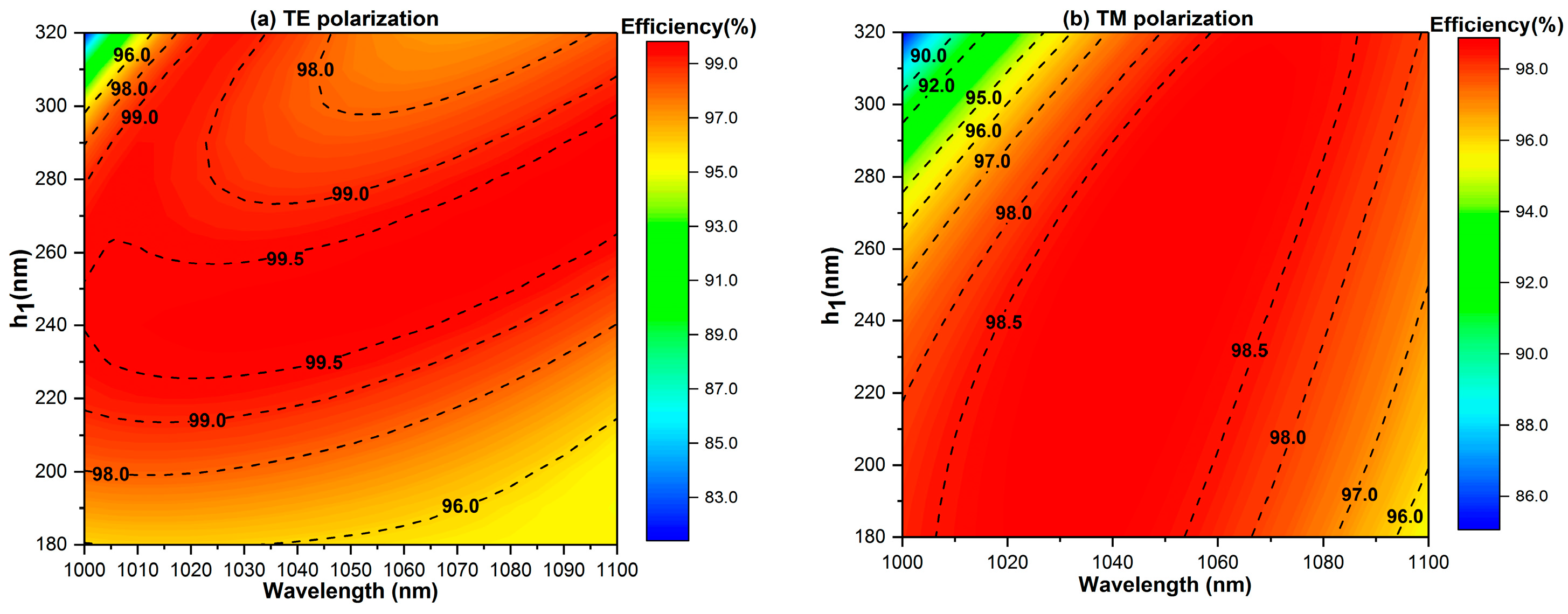
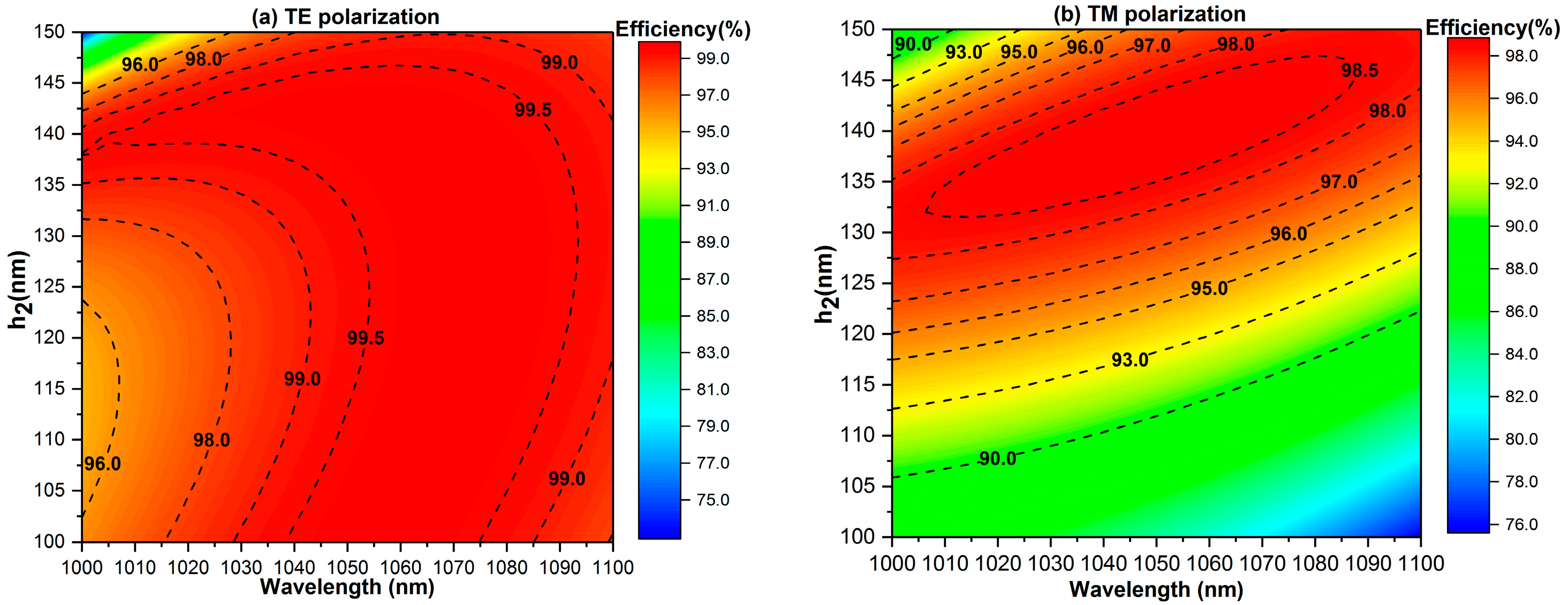

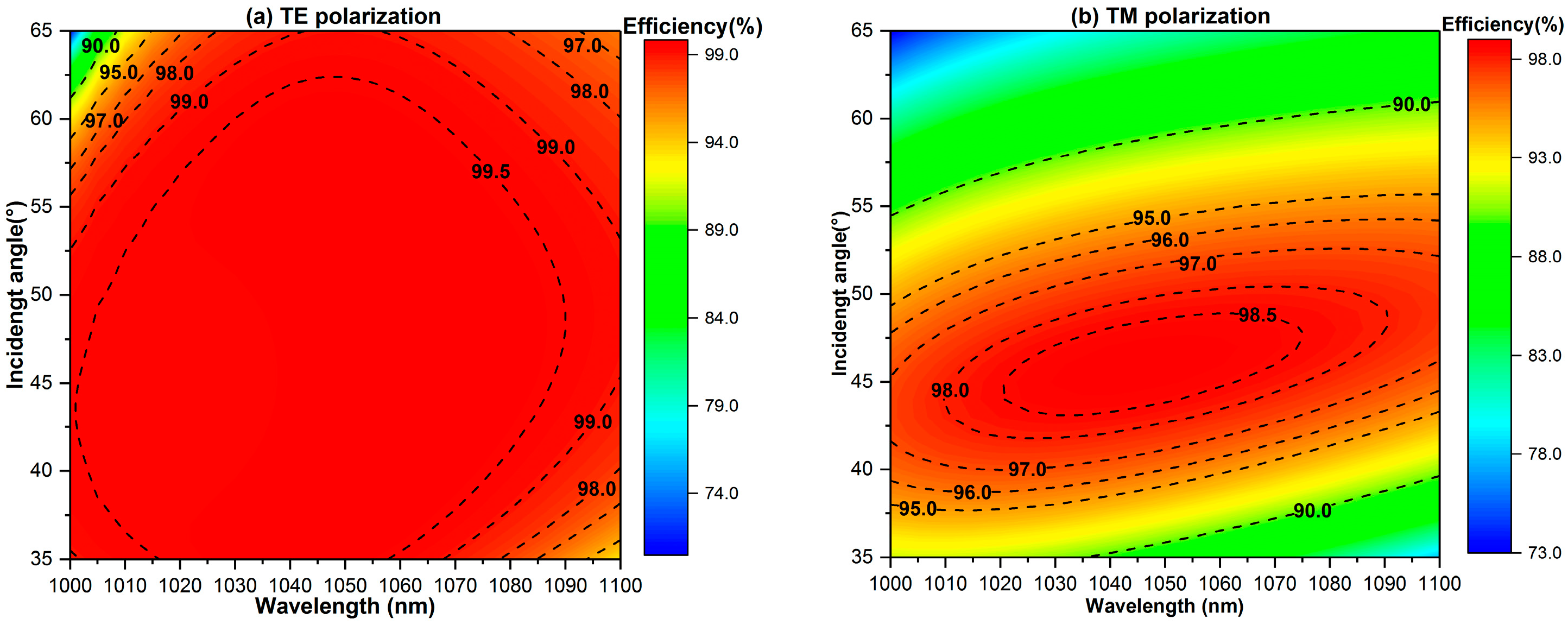
Publisher’s Note: MDPI stays neutral with regard to jurisdictional claims in published maps and institutional affiliations. |
© 2022 by the authors. Licensee MDPI, Basel, Switzerland. This article is an open access article distributed under the terms and conditions of the Creative Commons Attribution (CC BY) license (https://creativecommons.org/licenses/by/4.0/).
Share and Cite
Jin, G.; Jia, W.; Bayanheshig; Xie, Y.; Zhou, C. High-Efficiency Broadband Polarization-Independent Reflective Grating with Double-Layer Dielectric Rectangle Groove in Littrow Mounting. Appl. Sci. 2022, 12, 8612. https://doi.org/10.3390/app12178612
Jin G, Jia W, Bayanheshig, Xie Y, Zhou C. High-Efficiency Broadband Polarization-Independent Reflective Grating with Double-Layer Dielectric Rectangle Groove in Littrow Mounting. Applied Sciences. 2022; 12(17):8612. https://doi.org/10.3390/app12178612
Chicago/Turabian StyleJin, Ge, Wei Jia, Bayanheshig, Yongfang Xie, and Changhe Zhou. 2022. "High-Efficiency Broadband Polarization-Independent Reflective Grating with Double-Layer Dielectric Rectangle Groove in Littrow Mounting" Applied Sciences 12, no. 17: 8612. https://doi.org/10.3390/app12178612
APA StyleJin, G., Jia, W., Bayanheshig, Xie, Y., & Zhou, C. (2022). High-Efficiency Broadband Polarization-Independent Reflective Grating with Double-Layer Dielectric Rectangle Groove in Littrow Mounting. Applied Sciences, 12(17), 8612. https://doi.org/10.3390/app12178612




